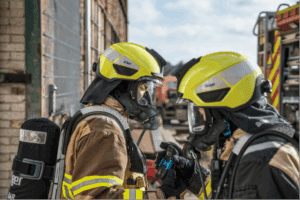International Fire Buyer looks at the different types of fire pumps available for installation and firefighting use and their efficiency
Fire pumps are an essential part of many water-based fire protection systems. They are used to increase the pressure (measured in psi and bar) of a water source when that source is not adequate for the system it’s supplying. These are commonly found in buildings that tend to have a high-pressure demand such as high-rises or storage warehouses and on fire trucks.
There are many types of fire pumps available. It is important to select the correct type of pump for the installation project to avoid excessive costs, and to avoid excessive pressures that might damage your system. If all the factors are not taken into consideration it could result in a pump installation that does not achieve the necessary pressure requirements which could require a new pump tobe installed.
There are two main categories of pumps for building installation: positive displacement and centrifugal.
Positive displacement pumps
Positive displacement pumps are characterised by a method of producing flow by capturing a specific volume of water per pump revolution and pushing it out through the discharge line. A bicycle tire pump is an example of a positive displacement pump we commonly see. Positive displacement pumps create very high pressures but have limited flow volume compared with centrifugal pumps. These are not as common because they have a specialized use, primarily with water mist and foam-water systems.
Centrifugal pumps
Centrifugal pumps are the most common fire pumps and are used with most systems. With centrifugal pumps, pressure is developed principally by the action of centrifugal force or spinning. Water in centrifugal pumps enters the suction inlet and passes to the center of the impeller. The rotation of the impeller, in turn, drives the water by centrifugal force to the rim where it discharges. Centrifugal pumps can handle large volumes of water while providing high pressure boosts.
The following are different centrifugal type pump configurations:
Horizontal split-case pump
With a horizontal split-case pump, the flow is split and enters the impeller from opposite sides of the pump housing. As the name implies, this is a pump installed with a split casing that can be opened for pump maintenance access and is connected to the driver by a horizontal shaft.
They are very reliable, come in a wide range of rated flow and pressure capacities, are easy to maintain due to their relatively easy split-case access, and can be used with both electric and diesel drivers. However, these also typically need the most space of all types of fire pumps.
Vertical turbine pump
A vertical turbine pump is the only type of pump allowed by NFPA 20, Standard for the Installation of Stationary Pumps for Fire Protection that can start with negative suction pressure or take water under a lift condition such as from a below grade source such as a river or subgrade tank. These pumps can be used with raw water sources such as ponds, lakes, and rivers. Vertical turbine pumps come in a wide range of capacities and pressures, and they can be used with diesel and electric drivers.
In-line pump
In-line pumps are useful where space is limited. These can be driven by both a vertical or horizontal shaft (end suction type). Vertical shaft types, which are the most common, have the driver located directly above the pump. These are typically one of the less expensive units and take the least amount of space but, they are also one of the more expensive to repair. Pump maintenance and repair can be difficult because the motor must be lifted off and removed to gain access to the pump, unlike a split-case unit. With these pumps, the suction flange and discharge flange are on approximately the same plane. In-line pumps have a limited capacity of typically no more than 1,500 gpm (5,678 L/min), and they can only be used with an electric driver which limits their potential applications.
End suction pump
An end suction pump has a discharge outlet perpendicular to the suction inlet. These pumps are typically limited to a capacity of approximately 1,500 gpm (5,678 L/min). Compared to horizontal split-case fire pumps, they are more compact and require less installation space in a fire pump room where available space is a concern. End suction pumps can be used with either an electric driver or a diesel driver.
Multistage multiport pump
Multistage Multiport pumps use a single-driver that can be either an electric motor or a diesel engine that connects to a pump with multiple impellers in series in a single casing driven by a horizontal shaft. The casing has multiple ports, or discharge outlets, delivering different pressures – each port has increased pressure from the consecutive series impellers.
For example, one multistage multiport pump could be installed in a high-rise building having 30 floors. The building may be divided into three zones where a multistage multiport pump equipped with three discharge outlets would use each outlet for a zone. The first has an outlet pressure of 100 psi (6.9 bar) and feeds lower floors or lower zone (ground to 9th), the second has an outlet pressure of 175 psi (12.1 bar) and feeds middle floors or mid zone (10th to 19th), and a third has a discharge pressure of 300 psi (20.7 bar) and feeds the upper floors or high zone (20th to 30th).
Using multiport fire pumps could result in:
- Fewer pumps required
- Less pipe work and fewer valves, as one pump could eliminate the need for some control valves and pressure reducing devices
- No requirement for water storage tanks on intermediate floors
- Lower structural loads and associated costs as only one pump may be required
- Energy conservation because less electricity and/or fuel will be consumed. Less pollution is also a potential benefit.
Firefighting pumps
Today’s firefighters face many challenges that had not previously been on the fire service’s radar, including:
- Residential structure fires burn 800% faster than legacy homes built before 1970 (when lightweight construction materials first came into widespread use).
- Those same fires produce more heat and more toxic smoke – smoke that’s laden with toxic chemicals, chemical compounds and carcinogens – than legacy homes, due to the widespread use of synthetic materials and fibers – many of which are petrochemical-based – for everything from the sheetrock and beyond.
- A growing body of knowledge links firefighter exposures to that toxic smoke with a much greater risk of developing cancer than that of the public.
- Water is becoming a valuable commodity in many communities, especially in western US states due to ongoing drought, and increased housing and business development. Rapid extinguishment, using less water, has become a critical component of the fire suppression strategy for many fire departments.
- Better building and fire codes have significantly reduced the threat of a major conflagration (other than wildfire) for many communities. Yet many of the fire departments protecting those communities still cling to the concept of “massive force” when it comes to fire suppression (e.g., 1000 to 1500 GPM pumps on fire apparatus carrying 1000 gallons of water or more responding to residential and light commercial structure fires where the water used to effect fire suppression is typically less than a couple hundred gallons.
The idea that water is not a perfect tool for fire extinguishment has been long noted, as by Former Fire Chief and Fire Protection SME, W. E. Clark; “The process of extinguishing fire by water is cumbersome and generally costly … the cost of installing water mains large enough for required flow; the installation and maintenance of fire hydrants; and the acquisition and maintenance of fire department pumpers, fire hose and nozzles, make water a fairly expensive extinguishing agent … the use of water is hardly the ideal way to extinguish fire … there must be a better method waiting to be discovered.”
CAFS
The first recognised compressed air foam systems (CAFS) was developed by a Texas Forest Service employee in the mid-1970s. That employee, Mark Cummins, developed a water expansion system to make better use of available water for fighting wildfires. The system developed by Cummins – which became known as CAFS – received U.S. Patent No. 4318443 in 1982.
Ultra high pressure fire pumps
A conventional low-pressure fire apparatus pump delivers between 20 gpm and 2000 gpm at discharge pressures that range from 120 psi to 300 psi. NFPA 1901: Standard for Automotive Fire Apparatus defines ultra-high-pressure pumps (UHP) as those pumps that have a minimum rated capacity of 6 gpm (25 L/min) and that have a rated discharge pressure greater than or equal to 1100 psi (7600 kPa).
The UHP pump produces incredibly small water droplets with four times the surface area of water droplets found in fire streams produced by conventional low-pressure fire pumps. And smaller sized water droplets – because smaller is better in this case –convert to steam more quickly.
When firefighters use a UHP pump, 90% of the water either arrives at the burning fuel or converts to steam. And as we know from basic fire science classes, steam conversion is the critical factor in using water for fire suppression. Steam is what takes energy out of a fire, while at the same time, displacing the oxygen the fire needs to continue burning.
Ultimately, there are several different pumps that can be used in a variety of situations. When your system demand exceeds what your water supply can provide it’s time to look at what a fire pump can do to help bridge that gap. For more guidance see NFPA 20 for installation requirements and NFPA 25 Standard for the Inspection, Testing and Maintenance of Water-Based Fire Protection Systems, for ITM requirements. The days are numbered for the conventional low-pressure pump found on most fire apparatus today. Both CAFS and UHP pumps are more efficient and effective tools for fire suppression. Beyond that, they can be force multipliers that provide fire departments struggling with reduced staffing with big time fire suppression capability.

In the 1950s, the high pressure extinguishing process was developed at a water pressure of 40 bar. Since then, Rosenbauer has been the leading firefighting pump manufacturer, with combined normal pressure / high pressure pumps. The pump can extinguish with high pressure misting or normal, and, if need be, both simultaneously. The high-pressure mist extinguishing method achieves the greatest possible extinguishing effect with the minimum amount of water.
The principle of high-pressure extinguishing is thus: The finer the water droplets, the faster the water evaporates, the better the extinguishing effect. Water that does not evaporate is technically wasted, and causes unnecessary water damage, especially in the case of relatively small fires. Of course, you will not extinguish a raging fire with high pressure extinguishing, but in the event of small fires and single-room fires as well as in incipient fires, high pressure is a very effective extinguishing method, which nowadays is even used in firefighting vehicles from Rosenbauer in the United States of America.
The USA is traditionally known to “flood” fires with as much water as possible, regardless of the resulting water damage. The ideal solution for the internal extinguishing attack is our combined normal pressure / high-pressure pump in conjunction with our high-pressure hose reel and the Rosenbauer NePiRo spray pistol.

Fire pumps are an essential part of many water-based fire protection systems. They are used to increase the pressure (measured in psi and bar) of a water source when that source is not adequate for the system it’s supplying. These are commonly found in buildings that tend to have a high-pressure demand such as high-rises or storage warehouses. This blog will review the different types of fire pump options available to designers.
There are many types of fire pumps available. It is important to select the correct type of pump for the installation project to avoid excessive costs, and to avoid excessive pressures that might damage your system. If all the factors are not taken into consideration it could result in a pump installation that does not achieve the necessary pressure requirements which could require a new pump tobe installed.
Ultimately there are several different pumps that can be used in a variety of situations. When your system demand exceeds what your water supply can provide it’s time to look at what a fire pump can do to help bridge that gap. For more guidance see NFPA 20 for installation requirements and NFPA 25 Standard for the Inspection, Testing and Maintenance of Water-Based Fire Protection Systems, for ITM requirements.

The number one concern for a firefighter is where the water supply is going to come from. That does not matter if it is in Municipal Firefighting or Industrial Firefighting. Using submersible pumps is nothing new as they have been around for hundreds of years, and until now the use of the submersible hasn’t been widely adopted.
I have a great example of a recent emergency response where we were contracted for services. The water main providing water supply to the plant was compromised during the explosion. This left the hydrants and fire water supply out of service. The fire was still raging and there were spheres that had product inside and they needed to be cooled immediately to avoid secondary explosions. After scouting the area for water, we found a river a little over 1.5 miles away. We deployed our 10,000 gpm submersible pumps into the river, giving us unlimited water supply, which fed our in-line boost pumps all the way back to the scene. With the use of the submersibles to provide the much-needed water, the surrounding community was spared a major disaster.
Using submersible pumps, in many cases, allows for greater water flow than can be achieved with hydrants or drafting pumps. For example, one single submersible pump can supply either 3,000 or 5,000 gpm and can fit in the back of a standard pickup truck or mounted to a small trailer. Both of these single submersible pumps have been a popular option among municipalities and smaller industrial complexes. For example, municipalities have deployed, into a static water source, one 3,000 gpm submersible pump and supplied up to three fire engines during firefighting operations. The most popular combination used by industrial complexes has been using dual 5,000 gpm submersible pumps to achieve their desired flow of 10,000 gpm. This can also be configured with three and four 5,000 gpm submersible pumps to achieve higher flows of 15,000 and 20,000 gpm, respectively.
To stay up to date on the latest, trends, innovations, people news and company updates within the global fire market please register to receive our newsletter here.
Media contact
Rebecca Morpeth Spayne,
Editor, International Fire Buyer
Tel: +44 (0) 1622 823 922
Email: [email protected]




































